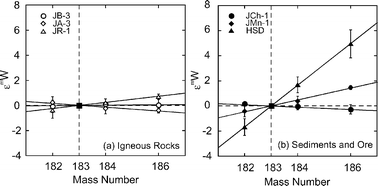We have measured 182W/183W, 184W/183W, and 186W/183W ratios for two W standard solutions (NIST-3163 and JMC-22841) and six geochemical reference materials (JB-3, JA-3, JR-1, JCh-1, JMn-1, and HSD), by means of multiple collector-ICP-mass spectrometry (MC-ICP-MS). In this study, a Re-external correction technique was employed to detect possible isotopic fractionations of W through a sample formation sequence. In order to obtain further reliable and traceable isotopic data, we introduced the newly defined mass bias factor (γ) into the exponential law. When the γ value was optimized to 1.151 ± 0.017, resulting 182W/183W, 184W/183W, and 186W/183W ratios were 1.851 86 ± 0.000 08, 2.141 05 ± 0.000 08, and 1.987 606 ± 0.000 002, respectively. Reproducibility in the W isotopic ratio measurements was better than 0.05‰ for all the ratios, demonstrating that no significant deterioration in the analytical uncertainties was found from the data obtained with the conventional correction technique using the exponential law. In order to minimize possible isotopic fractionations through the chemical separation and purification processes, great care must be taken in the recovery of W. We have estimated the total recovery of W through the chemical decomposition and separation procedures by repeating the analysis of W abundance from a rhyolite standard rock sample (JR-1), and the resulting W recovery was 97.8 ± 6.5% (n = 5). Based on the isotopic data obtained through the ion chromatographic separation revealed that the isotopic fractionations of W are less than 0.02‰, and this is almost comparable to the analytical precision achieved here. No significant variation in 182W/183W ratio due to radioactive decay of 182Hf could be found for all the samples analyzed in this study. Despite the absence of radioactive isotopic variation of 182W/183W ratio, resulting 182W/183W, 184W/183W, and 186W/183W ratios for W reagents and geochemical reference materials revealed that W suffered from mass-dependent fractionation through the sample formation. The W isotopic ratios of JMC-22841 were 0.06‰ amu−1 lighter than those of NIST-3163. In contrast, the W isotopic ratios collected from hot spring deposit (HSD) were 0.15‰ amu−1 heavier than those of NIST-3163, which show that the overall degrees of isotopic variations were 0.21‰ amu−1. These data demonstrate clearly that W isotopes can be used as a new tool for stable isotope geochemistry.


 Please wait while we load your content...
Please wait while we load your content...